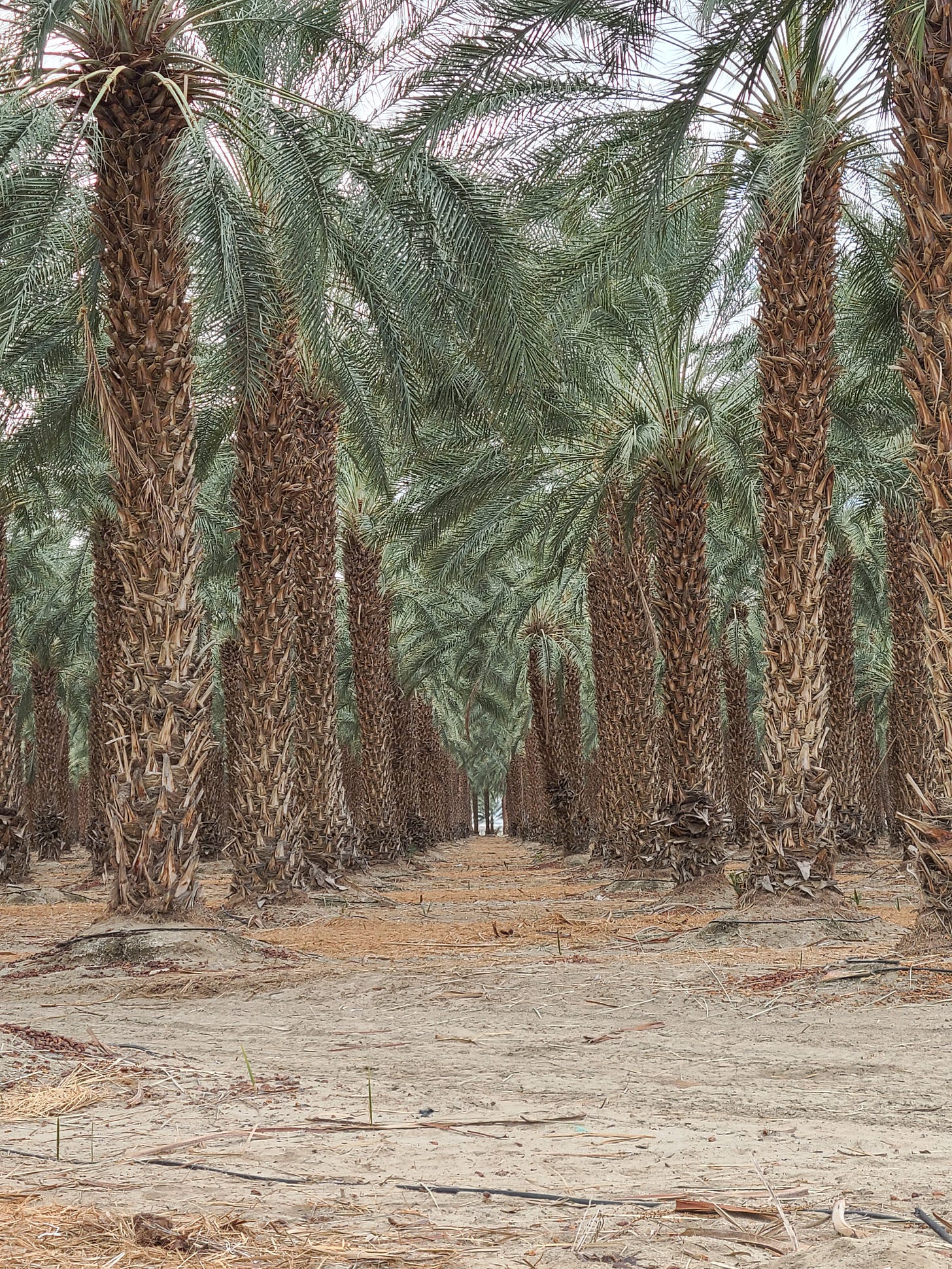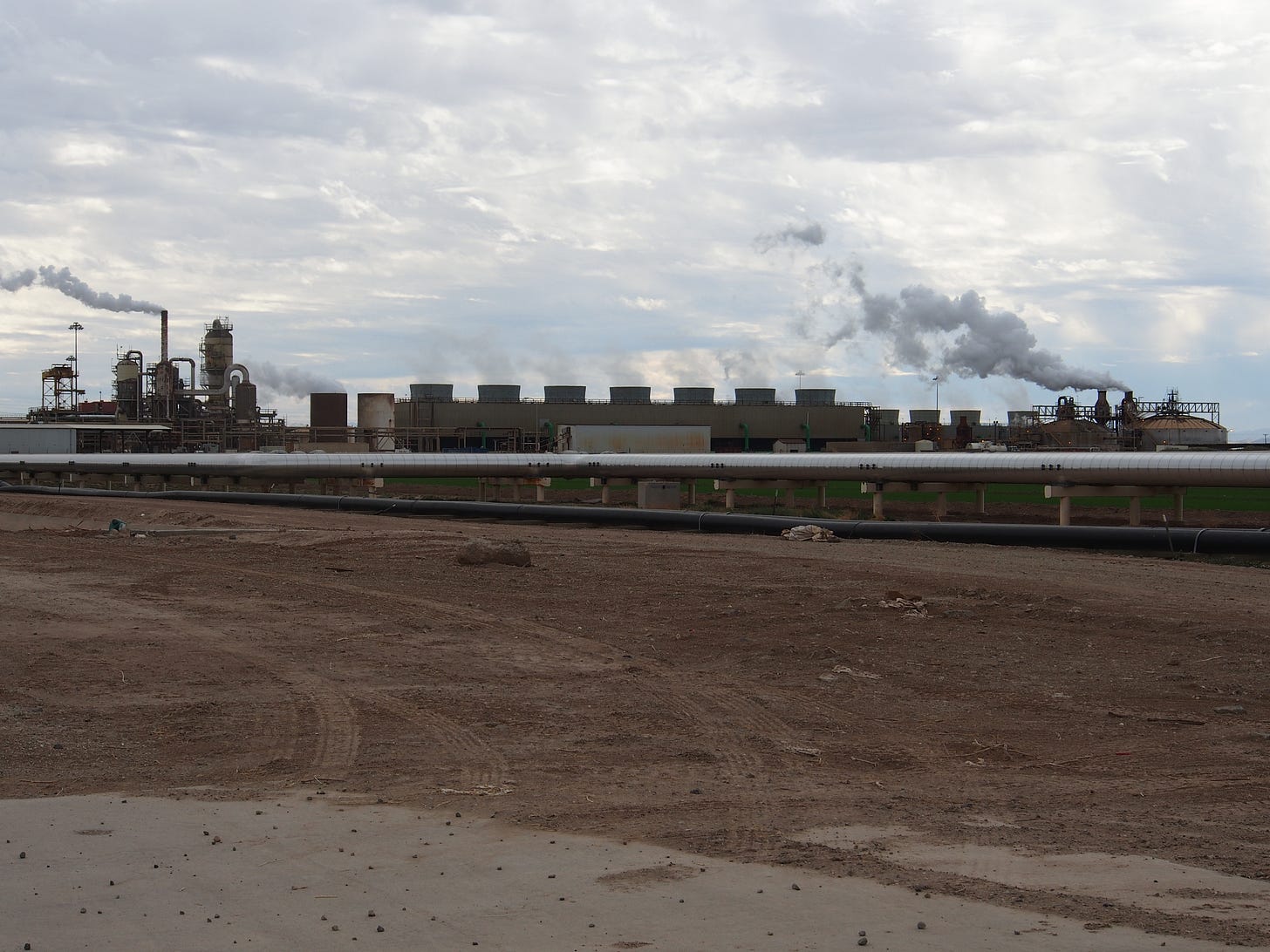Bike
Part 2 of chasing triathletes and water through the Coachella Valley
This is also one a series of essays looking at places we travel through the lens of water, a lens through which we can see the unseen.
Part 1 found our Ironman 70.3 triathletes completing the swim in Lake Cahuilla and heading out on the bike. The bike route takes our triathletes east from the lake on Jefferson Street past half a dozen other dead presidents into the town of Thermal, and then south on Pierce Street. They ride slightly downhill, now below sea level, on gradually deteriorating roads past fields of produce, herbs, grapes, peach and citrus orchards, and the date palms of the town of Mecca, to the turn-around in the "census designated place" of Oasis, most of which is within the reservation of the Torres Martinez Desert Cahuilla Indians.
Oasis is over 97 percent Hispanic. The residents are mostly farm workers, some without documentation, who toil in heat over 110 degrees harvesting produce for our supermarkets. Many live in makeshift mobile home parks within the reservation, where they and the park owners alike, are out of reach of county officials. Once such, is just half a mile from the bike route and a little before the turnaround at almost 200 ft below sea level.
Also beyond the reach of state and county officials is the drinking water in these mobile home parks. Primacy for regulation of drinking water on tribal lands resides with the federal government in the form of the Environmental Protection Agency and is not devolved to the states. So far, only the Navajo Nation has asked for and obtained drinking water primacy on its tribal lands. The EPA has found unsafe levels of arsenic in the drinking water of four of these mobile home parks and has filed a complaint against one owner. Meanwhile, a non-profit distributes bottled water. The electricity supply and sanitation are also unreliable. The County received a $30 million State grant to move people out of one park, but as fast as they move out, the owners are allowing new tenants to move in. The low wages in agriculture, the shortage of low-income housing, and the undocumented status of some of the residents makes relocation a challenge. It may take several years.
Colonies are not just on foreign shores. Sometimes they're hiding in plain sight.
Our cyclists turn around in Oasis, but we're going to follow the water a while longer. Half a mile from the bike route is The Whitewater River. It runs, if that word is applicable, from the San Bernadino Mountains through the length of the Coachella Valley to the Salton Sea. Although water from the Colorado River Aqueduct (discussed in part 1) is fed into the river, it's pulled out again to recharge the aquifer. By the time the river terminates in the Salton Sea, just past our bike turnaround, it's been lined with concrete and sadly but accurately renamed the Whitewater Stormwater Channel. It's dry, except during storms like hurricane Hilary. The little water from the valley that makes it to the Salton Sea does so through drainage ditches carrying pesticide and fertilizer laden agricultural runoff.
Although the prehistoric Lake Cahuilla, not to be confused with today's reservoir, filled the Salton Sink many times, at the beginning of the 20th century the sink was dry. An accident during construction of the All-American Canal led to the entire flow of the Colorado River being diverted into the sink for two years, forming the Salton Sea. A few years later, resorts sprang up around this new oasis, with luxury homes and marinas—Desert Shores, Salton Sea Beach, and Bombay Beach. The lake surface is 232 feet below sea level. The area is the southern tip of the Great Basin, the largest endorheic basin in the US. What happens in the Salton Sea, stays in the Salton Sea.
To the south of the Salton Sea are the farms of the Imperial Irrigation District, supplied by the All-American Canal. For years, these and the farms of the Coachella Valley used flood irrigation, and the runoff balanced evaporation and kept the lake level high. As water demand from housing increased and agricultural practices became more efficient, first sprinklers, then drip irrigation, the volume of runoff has decreased, causing a drop in the lake level and a buildup of salinity and contaminants. Much of the remaining flow at the south end comes from the New River, which starts across the border in Mexico and then picks up runoff from fields and the huge dairies in Niland and Calipatria which it dumps into the lake. Beef, and particularly dairy farms and their alfalfa feed, account for the largest share of agricultural water use in California. As Marc Reisner puts it the afterword to the 2017 revised edition of Cadillac Desert:
California has as a shortage of water because it has a surfeit of cows—it's really almost as simple as that.
As the lake recedes, the beaches are being replaced with toxic mud and dust. As the dust blows around it contributes to the highest rates of asthma in California. The resorts and marinas have been left high and dry, but far from being ghost towns, these resorts, particularly Bombay Beach, are enjoying second lives as post-apocalyptic artist colonies.
Although the salinity and toxicity have reduced wildlife in the lake to one species of particularly hardy fish, it remains important bird habitat, particularly as a stopover for migratory birds on the west coast flyway. The Sonny Bono wildlife refuge is at the southern end of the lake, sandwiched between the mega dairies of Calipatria to the east and a lithium and geothermal plant to the west, which pumps up brine, extracts heat and a tiny but economically worthwhile amount of lithium, and pumps it back down into the earth.
The Imperial Irrigation District owns some of the oldest water rights in California. The head of the district will be the lead negotiator for the State of California at the annual meeting of Colorado River states. Although federal funding has persuaded some farmers in the district to fallow fields to reduce water use, that water is reserved for more development, not to replenish the lake. Mitigation around the lake is focusing on limiting the dust hazard. Without a new source of water, a challenge in the parched west, the future of the lake looks bleak.
Meanwhile our cyclists are heading back past the trailer parks and the fields. Just five miles north of the potholed roads of Oasis, the athletes turn on to the perfectly smooth pavement of The Thermal Club, a private racetrack, where your friends can watch you race your car from the deck of your private villa. After exiting the racetrack, our riders pass the future site of The Thermal Beach Club, a luxury residential community with a 20-acre man-made surf park. The project received unanimous approval from the Riverside County Board of Supervisors. According to this article in the Desert Sun:
The project has drawn controversy for being a high-priced, members-only club that will be built in a low-income area that's home to many farmworkers and is predominately Latino, according to U.S. Census data. Critics point to the fact that nearby residences lack access to utilities like water and sewage lines. The median household income in the census tract where the club will be located is about $29,500, according to the latest American Community Survey, compared to $53,539 for the Coachella Valley.
I have nothing to add to that, really. Water is a lens which makes the invisible, visible. But we can still choose not to see it.
Our athletes are on their way to the Indian Wells Tennis Center, where they'll transition to the run stage. We'll pick them up, with the water story, in part 3.
Oh, how did my wife do? Glad you asked! First on the bike in her age group in 2:45:09 with another PR. On to the run!
Thanks as always for reading or listening. Please join me in the comments, and feel free to share.







“ Water is a lens which makes the invisible, visible.” Thank you for helping us see it.
Cheers to your wife! Incredible.